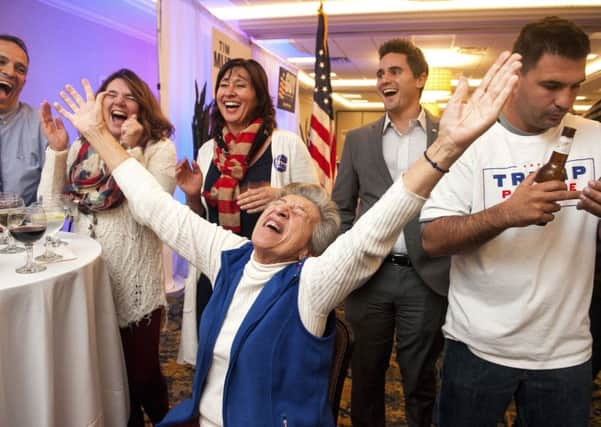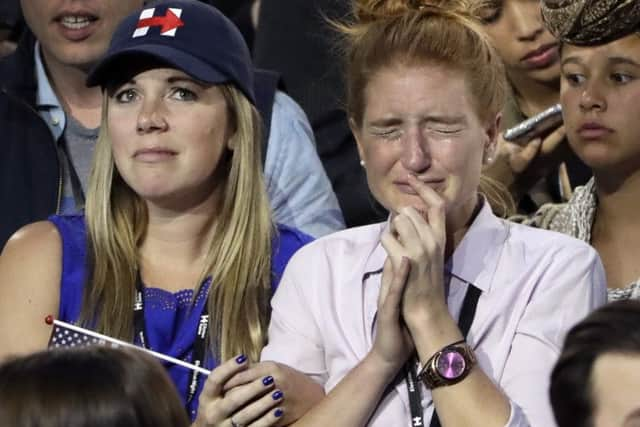In the UK and US, the very notion of left and right is breaking down


• The 2015 general election in which Ukip and the Tories take half the UK vote, a tally that was unprecedented for the political right since the 1950s.
• The May assembly election in which the DUP sweep the board.
• Brexit in June.


• And then this in America yesterday.
In all four cases, the pundits were confounded.
In all four, the same thing seems to have happened.
Advertisement
Hide AdAdvertisement
Hide AdA vast but quiet section of the electorate draws a line in the sand on similar or overlapping matters:


They made clear they are not going to be dictated to by the Scots, or the EU, or have their Britishness be diluted, or be told that they are bigots, or simple-minded patriots.
In each case there is a fear of the erosion of the dominant culture in their countries, alongside a fear they will be demonised for defending that traditional prevailing culture.
In each case the blue collar class were at the heart of it.
Advertisement
Hide AdAdvertisement
Hide AdPeople who work hard but expect other people to work hard too, and people who in many places have to live amidst the mass immigration that they are told they are racist for opposing and which they feel threatens their jobs.
The blue collar trend applies to Northern Ireland too. In exit polls that I carried out for this newspaper in East Belfast in 2010 and 2015 I was struck by how class-based the division seemed and this was backed up by tallies from other polling station boxes.
In the leafiest parts of the constituency, Naomi Long won emphatically.
In the most working class areas, Gavin Robinson won to an even more overwhelming degree than she did at the other end of the spectrum.
Advertisement
Hide AdAdvertisement
Hide AdHere in North Carolina, and across America, the same trend has played out.
Support for Donald Trump was much higher among the working classes, although it did spread all the way up the social scale (as did support for Brexit and the DUP this year).
The very concept of left and right wing is being rewritten.
For more than a century the poorest sections of society have been most likely to vote for parties of the left, which were founded to fight for them, and the more affluent sections of society were most likely to vote for the parties of the right.
There have always been exceptions, such as champagne socialists (called limousine liberals in America) and members of the working class (the sort of people who deserted ‘loony left’ Labour in the early 1980s over issues such as defence or the party’s support for the emerging and then radical concept of gay rights).
Advertisement
Hide AdAdvertisement
Hide AdIn the 1980s, there were Reagan Democrats: blue collar voters who were attracted to the traditional values and patriotism that he embodied.
In Northern Ireland unionist political representatives of the loyalist working class were on the political right, because ‘right’ in that context was defined primarily by positions such as law and order and a tough response to terrorism.
These have become dominant factors in England and America too at a time of an Islamic terrorist threat.
But now some of these longstanding underlying political trends have become an earthquake.
Advertisement
Hide AdAdvertisement
Hide AdHence why last year it had been assumed that a strong Ukip vote would most damage the Tories, but in 2015 it affected Labour more than the Conservatives as working class patriots deserted the establishment party of the left.
This week there has been a similar surprise in America.
States that the Democrats had not at first even thought to defend such as Michigan, seen as safe for Hillary Clinton, were suddenly found to be in play late in the contest, causing her to have to dash there.
This was due to the rise of blue collar support for a Republican candidate, Donald Trump, that they could understand.
These are voters who might not be hostile to issues such as feminism or civil rights but they are increasingly disinclined to back candidates who seem to prioritise such matters – as Hillary Clinton was perceived to have done – when they have jobs and incomes to worry about.
Advertisement
Hide AdAdvertisement
Hide AdHowever, this victory for Mr Trump is not a complete endorsement of him.
Aside from the narrowness of his victory margin, and indeed his loss of the nationwide popular vote to Mrs Clinton, Mr Trump’s vote was down more than one million on the 61 million votes won by Mitt Romney, the Republican candidate in 2012. Hillary Clinton’s vote was down by an even larger margin on Barack Obama’s total four years ago.
Both candidates were unpopular and around six million Republican or Democratic voters either stayed at home compared to 2012, or switched to minor candidates.
All of this was apparent at St Matthew AME church, a polling station in Raleigh, North Carolina where I spent the day on Tuesday.
Advertisement
Hide AdAdvertisement
Hide AdNorth Carolina was one of the critical swing states, and Raleigh is in Wake County, which was one of the swing counties within the state.
I went to St Matthew AME because it had large numbers of both white and African American voters, and race was one of the key determinants in how people voted.
During the day I talked to scores of voters and carried out a small exit poll of 94 voters, to get a sense of who was voting which way and how.
I have done many such exit polls in places from Northern Ireland to Scotland on referendum day to Dundalk on the day of the same-sex plebiscite.
Advertisement
Hide AdAdvertisement
Hide AdIt has surprised me how forthcoming people are about admitting their voting preference to a journalist stranger after coming out of a polling station. This was so in 2008 when I was in Indiana on the day Barack Obama was elected, and I got an early glimpse of his dramatic victory in that normally Republican state.
But on Tuesday in Raleigh I had an unusually high number of people who would not tell me how they had voted, and they were far more likely to be white.
Out of 73 white voters I approached, 21 would not say how they voted. But only three out of 21 black voters were similarly reticent.
This was probably a sign of the ‘shy’ Trump voter that has confounded the pollsters.
Advertisement
Hide AdAdvertisement
Hide AdIt was in anticipation of this sort of factor that I wrote on Monday that I was not convinced Hillary would win in the way that the polls said, because increasingly it seems to me that pollsters cannot gauge the views of modern societies with sufficient accuracy.
This is partly due to diverging lifestyles between the generations (how they access phones for example) but also perhaps due to the growing fear of censure of traditional views on matters such as immigration and same-sex relations.
On Tuesday I encountered deep hostility to both main candidates in the voters to whom I spoke.
In the coming days I will share more of my findings from Raleigh.
• Ben Lowry (@BenLowry2) is News Letter deputy editor
Advertisement
Hide AdAdvertisement
Hide Ad